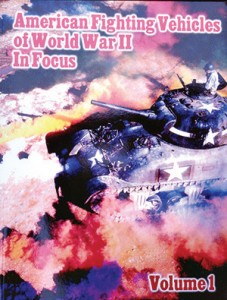Review by Larry S. Sterett | Contributing Editor
AMERICAN FIGHTING VEHICLES OF WORLD WAR II IN FOCUS, Volume 1.
Compiled by Ray Merriam, © 2014
Published by Merriam Press
133 Elm Street, Dept. TGM
Bennington, VT 05201.
Price: $39.95, plus shipping. Available direct, or in some bookstores.
This 102-page softbound, magazine size volume is really a photo album, illustrated with just under 300 captioned photographs, three per page.
The vast majority of the photographs are black and whites, with just a few color shots, including the final one which is the same as the front cover.
The bulk of the photos are combat views taken during the island hopping campaign in the Pacific Theater.
However, there are a number of photos illustrating tanks, etc., taken in the US, the European Theater, North Africa, and elsewhere, in addition to two sectionalized labeled drawings illustrating the various features of the M4A4 tank.
Some of the photos not often seen include the improvised hedgerow shears or cutters welded onto the front of some tanks to assist in getting through the ‘bocage’ in Normandy.
(Ordnance men used angle iron cut from the German beach obstacles to form pointed shears designed to dig into and plow through the hedgerows.
Crude, but they did the job!) Photos of the Duplex Drive Tank (DD Tank) are rather scarce, but there are a couple in this volume. The DD Tank, with its flotation device raised, was an awkward-appearing object, and it did not always function properly in rough seas. More such tanks on D-Day probably did not make it ashore than did; they swamped and sank prior to reaching solid terrain.
The many field improvisations made to the various vehicles are interesting to see. Among these are the Jeep with two Bazookas mounted in place of the .50 caliber machine guns, tanks with assorted hedgerow cutters mounted on the front, and tanks with wooden planks on the sides and gear to discourage the attachment of magnetic mines.
There are several good photos of the DUKW (“Duck”), and of the lesser known M29 “Weasel” Amphibious Tractor. Both vehicles did the jobs they were designed for, but the DUKW is definitely the better known of the two.
This is one of the few books in which illustrations of the “Peep,” “Jeep,” and “Seep” have all appeared. The “Seep,” or Amphibious Jeep resembles a very small DUKW with only four wheels in place of six. The ¼-ton “Peep,” except for the front fenders and some other relatively minor features, resembles the later ¼-ton “Jeep.” There was also a waterproofed Jeep, which was not the same as the Seep. Interesting! Anyone with an interest in America’s WWII combat vehicles should find this a valuable reference guide. It’s main disadvantage is the lack of an index so a particular vehicle can be easily located.




